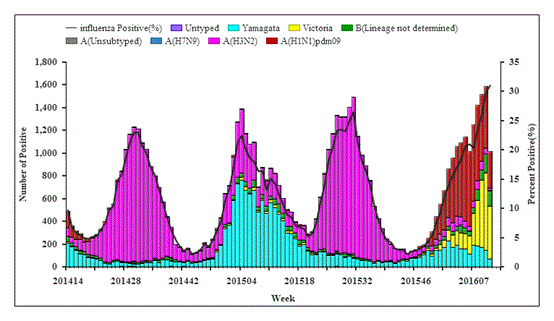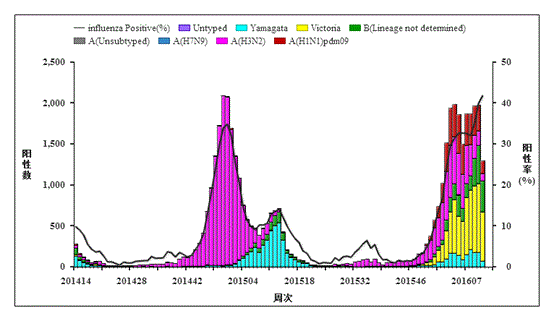Font: Small Medium Large [print] Release: 2016-03-28 09:50:21 Submitter: YangLei hits:36
Chinese Influenza Weekly Report
(All data are preliminary and may change as more reports are received)
Outbreak Surveillance
During week 11(March 7-20, 2016), there was 160 outbreaks reported nationwide, 105 of them were B, 14 of them were A(H1N1)pdm, 5 of them were negative , 18 of them were mixed, and 18 of them were untyped.
Surveillance of outpatient or emergency visits for Influenza-like Illness (ILI)
During week 11, the percentage of outpatient or emergency visits for ILI (ILI %) at national sentinel hospitals in south China was 3.9% , higher than last week, the same week of 2014 and 2015(3.6%、3.0%和2.5%). (Figure 1)

Figure 1. Percentage of Visits for ILI at Sentinel Hospitals in South China (2011-2016)
During week 11, ILI% at national sentinel hospitals in north China was 4.0%, higher than last week, the same week of 2014 and 2015(3.8%、2.9%和2.6%). (Figure 2)

Figure 2. Percentage of Visits for ILI at Sentinel Hospitals in North China (2011-2016)
Virologic Surveillance
During week 11, influenza network laboratories tested 6344 specimens, of which 2308(36.4%) were positive for influenza, influenza A and influenza B virus were 598(25.9%) and 1710(74.1%), respectively(Table 1). During week 11, the percentage of specimens that were tested positive for influenza in south China was 31.0%, which was higher than the previous week (29.8%) (Figure 3). During week 11, the percentage of specimens that were tested positive for influenza in north China was 42.1%, which was higher than the previous week (41.5%) (Figure 4).

Figure 3. Influenza Positive Tests Reported by Southern Network Laboratories (Week 14, 2014–Week 11, 2016)
Note: Analysis in this part was based on the test results of network laboratories. If it were not consistent with the results of CNIC confirmation, the results of CNIC confirmation were used.

Figure 4. Influenza Positive Tests Reported by Northern Network Laboratories (Week 14, 2014–Week 11, 2016)
Note: Analysis in this part was based on the result of network laboratories. If it were not consistent with the results of CNIC confirmation, the results of CNIC confirmation were used.
Antigenic Characterization
Since October 1nd, 2015, 267(94.3%) of the 283 A(H1N1)pdm09 viruses tested were characterized as A/California/7/2009-like; 47(29.2%) of the 161 A(H3N2) influenza viruses tested were characterized as A/Switzerland/9715293/2013 (H3N2)(EGG)-like, 125(77.6%) of the 161 A(H3N2)influenza viruses tested were characterized as A/Switzerland/9715293/2013 (H3N2)(CELL)-like; 170(98.3%) of the 173 influenza B/Yamagata lineage viruses tested were characterized asB/Phuket/3073/2013-like; 62(47.0%) of the 132 influenza B/Victoria lineage viruses tested have been characterized as B/Brisbane/60/2008-like.
Antiviral Resistance
Since October 1nd, 2015, among the influenza viruses tested by CNIC for antiviral resistance, all influenza A(H1N1)pdm09 and all influenza A(H3N2) viruses were resistant to adamantine ; all influenza A(H1N1) pdm09 、A(H3N2) and B viruses were sensitive to neuraminidase inhibitors.